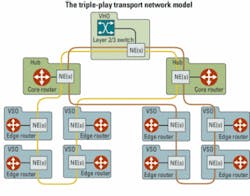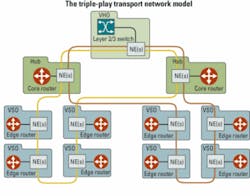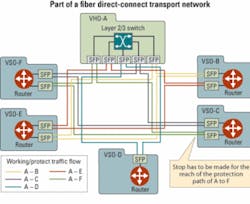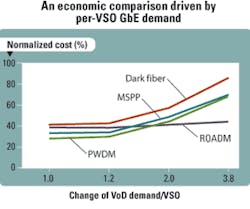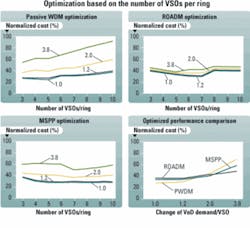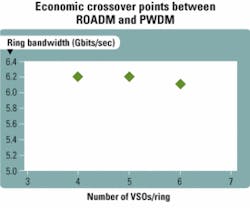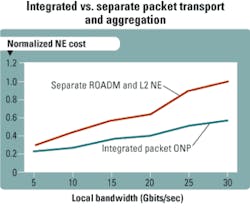Economic considerations drive choice of triple-play transport
by Sunan Han, Sam Lisle, and Greg Nehib
Telecom carriers in North America are rapidly rolling out a variety of residential video services including linear broadcast and video-on-demand (VoD), in addition to the existing high-speed Internet (HSI) data and voice services. The transport network to support such services usually involves one of three nodal architectures-based on reconfigurable optical add/drop multiplexers (ROADMs), multiservice provisioning platforms (MSPPs), or a router that is directly connected to other routers over fiber or through a passive DWDM system. Transport providers must consider each of these approaches carefully to find which one best maximizes profitability.
Transport networks within a metro area often deliver triple-play services from a single video headend office (VHO) to all the video serving offices (VSOs) for broadcast video and VoD content, or from two hub locations to all the VSOs for HSI service and voice over IP (VoIP). A typical triple-play transport network in a metro area consists of one VHO, two hub offices, and a number of VSOs.
Figure 1 shows a network with 11 nodes. Eight VSOs are connected through two rings (four per ring) to the VHO and two hubs. The edge router at each VSO routes and aggregates local loop traffic (i.e., from DSLAMs) and feeds the traffic in Gigabit Ethernet (GbE) circuits to the transport network. The ring topology in the transport network provides two protected paths for video traffic between the VHO and a VSO and two protected paths for HSI traffic between the hubs and a VSO.
Each of the typical transport options offers a viable method of creating a triple-play network-at least, in some cases, as long as certain conditions are met.
Router directly connected over fiber: Figure 2 shows a simplified network with five VSOs in a serving ring with 8-mile maximum spans. The boxes labeled “SFP” indicate small-form-factor pluggable optics. This network has only one VoD GbE connection between each VHO and each VSO.All video traffic is protected in the network and at each interface. The working and protection GbE circuits are routed separately over different sides of the ring from the VHO to each VSO. Assuming the SFP reach is 25 miles, the protection path of the GbE from VSO-F to VHO-A runs out of reach and therefore has to make a stop at VSO-C and passes through another router. Similarly, the GbE circuits from VSO-E, VSO-C, and VSO-B all stop at an intermediate node. However, both the working and protection paths of the GbE circuit from VSO-D have enough reach to get to VHO-A without stopping at any intermediate nodes.
Router directly connected over passive WDM (PWDM): The fiber direct-connect approach surveyed in the last section can be used as a quick service turn-up method in situations when the traffic demand is small and sporadic, such as in a small metro market. However, this approach is not economical as demand grows and fiber costs become overwhelming. Fiber availability is another issue that may prohibit its adoption. Consequently, PWDM can be used to achieve fiber relief in every span of the transport rings. However, each GbE port from the router is now connected to a PWDM node through a more expensive, narrowband optical SFP as a low-speed wavelength. The PWDM multiplexes the wavelengths onto a single fiber for transport.
MSPP-based SONET transport: The advantage of SONET is that it is a well-established technology in every North American telecom carrier’s infrastructure today. OC-192 rings can be employed as an efficient transport pipe to carry eight full-speed GbE circuits per ring. The power of SONET is its granularity and its ability to handle traffic at the STS-1 level. This is especially useful for mixing the broadcast traffic with others in the OC-192 pipes where the unidirectional broadcast demand can be treated as “drop and continue” on a per-STS-1 basis to achieve multicasting.
ROADM/DWDM transport: DWDM is recognized as the most efficient transport technology in high-volume service deliveries.1 Considering the potential bandwidth explosion from VoD as well as HSI demand, DWDM could be the most powerful and scalable technology approach.
The ROADM at each VSO uses optical drop-and-continue capabilities to broadcast content from the VHO to all the VSOs in the ring. This linear video traffic is carried in a separate wavelength. One 10-Gbit/sec wavelength can carry eight to ten GbE circuits or broadcast packages.
ADM-on-wavelength (AOW) is a technology that incorporates the ADM function in a transponder.2,3 It improves transport efficiency by aggregating subwavelength traffic from the connecting nodes into a single wavelength, thus avoiding multiple point-to-point wavelengths and additional transponders.
This economic analysis compares the equipment and transport costs among the four transport approaches. Based on the triple-play transport network architecture discussed in the introduction, consider a large metro transport network of 60 VSO nodes and a VHO node. Two of the 60 VSOs are also hub nodes. Logically, the serving rings are created by embracing the VHO, two hubs, and a subset of VSOs. All rings come through the VHO and the hubs, but only one ring comes through a VSO (as in Fig. 1). The number of VSOs in each ring is uniform and is a variable that can be modified.When forming the serving rings, the circumference should not stay the same for all rings. A simple algorithm is used to calculate the ring distances by increasing the span lengths. The basic distance assumptions guarantee that the optics provided by the transport equipment, especially the router’s SFPs, will have enough reach to avoid any amplification and dispersion compensation requirement. When these conditions are violated, the economy will be tilted greatly toward an active DWDM approach that has a powerful optical bypass capability and built-in amplifiers and dispersion compensation modules.
In the first analysis, the traffic demand is on a per-VSO basis. The HSI demand is one GbE connection from each VSO to a hub at all times. For broadcast video, the demand is always two GbE connections per VSO. The VoD demand grows from 1 GbE per VSO to 1.2 GbEs (on average) per VSO, then to 2 GbEs and 3.8 GbEs. The sensitivity of the variables is such that a minor fluctuation of VoD demand growth does not affect the comparative results in a significant way.When the number of VSOs in a serving ring is fixed at five, the economic model generates the comparison chart in Fig. 3. The PWDM approach turns out to be the early leader with the lowest cost when per-VSO demand is low-one GbE for HSI, two GbEs for broadcast, and about one GbE for VoD. When the VoD increases to two GbEs per VSO, the ROADM approach starts to outperform PWDM.
Fixing the number of VSOs per ring at five may not be optimal for every scenario. To find the optimal representation for each scenario, we can vary the number of VSOs in every ring from three to ten for the three competitive approaches-direct-connect with PWDM, MSPP, and ROADM-to observe their performance as the number of VSOs per ring changes.When investigating a medium-sized metro network with 15 to 20 VSOs and the same traffic demand per VSO, the results are very similar to those in Fig. 3 and Fig. 4. It is clear that the fiber direct-connect approach is not a good option in large- and medium-sized metro areas.
In the planning stage of a triple-play transport network, it is very important to match the right technology with the actual demand of a specific metropolitan area to achieve the optimum economics. In the next study, we analyze a single triple-play transport serving ring with the options of using ROADM or direct-connect with PWDM technologies. From our previous discussion, PWDM is known for best performance at low traffic demand and ROADM is best for high traffic demand. We need to determine exactly when the two technologies cross over. The crossover time is characterized by the total ring bandwidth, which can be easily translated into the number of subscribers in the area covered by the triple-play serving ring.
The VoD demand is the main bandwidth driver, so this study is focused on determining the VoD bandwidth (or the range of the VoD bandwidth) at the point where the two approaches exchange economic positions. All other demand from HSI and broadcast remains the same as in the last study-one GbE per VSO for HSI and two GbEs per VSO for broadcast video at all times. The VoD ring bandwidth grows from 4 Gbits/sec to 20 Gbits/sec. The intention is to derive the crossover point guideline that is solely based on the serving ring bandwidth. To achieve this in the network design and equipment configuration, we have to model the ring with one number of VSOs at a time.
Figure 5 shows the crossover points, in gigabits per second, with four to six VSOs in the ring. For seven or more VSOs per ring, ROADM starts (at 4 Gbits/sec) with lower cost than PWDM. For two or three VSOs per ring, network designers can hardly find the fiber routes to connect all the VSOs without violating our span distance constraint that is set to avoid optical amplifiers. Consequently, we omitted these two end cases.To summarize, the crossover points fall in the range of 6.1 to 6.2 Gbits/sec of total ring VoD bandwidth. To understand the number of subscribers and the two boundary crossover points represented in the area covered by the triple-play serving ring, a customer take rate must be determined.
Let’s assume the MPEG-4 coding scheme is used. So a standard-definition (SD) video stream bit rate is 2 Mbits/sec and a high-definition (HD) bit rate is 10 Mbits/sec. We assume the subscriber take rate is 18% for SD and 8% for HD. Let the total VoD bandwidth in the area be BVOD and the total number of subscribers in the area be S, then,When BVOD = 6.2 Gbits/sec, S = 5,342. This implies that, for a metro area covered by a serving ring of the triple-play transport network, if the forecast indicates a growth of about 5,000 subscribers or more, ROADM will be the right technology for deployment in a telecom carrier’s triple-play transport network. If MPEG-2 is used for compression, S will be approximately equal to 2,800.
In addition to the aforementioned capital expense considerations, ROADM-based active DWDM systems present a number of operational advantages over architectures that interconnect routers over direct fiber or PWDM. In particular, ROADM systems provide substantial operational benefits by decreasing the time required to establish additional network capacity and greatly reducing the number of manual fiber interconnections that must be made at each junction point.
With a ROADM-based approach, the physical fiber plant is allocated only one time upon network installation, and each additional wavelength to a particular end office only requires site visits at the traffic source and sink locations-not at traffic pass-through locations. ROADM systems provide this benefit by leveraging amplifier technology that automatically adjusts its gain profile with the addition of new wavelengths.3
Applying integrated aggregation capabilities including TDM, Ethernet over SONET, and native Ethernet bandwidth management further improves the ROADM economic and operational model. These capabilities define an emerging class of optical networking equipment known as “packet optical networking platforms.” Figure 6 shows the normalized equipment savings realized by deploying such platforms with integrated Ethernet aggregation and ROADM capabilities versus deploying multiple individual network elements.
There are strong market forces driving telecommunications providers to deploy higher-speed Internet access services along with broadcast and interactive video services to residential subscribers. Deploying these services requires careful consideration of many aspects of the metro network architecture, including the architecture for the Layer 1 optical network.
This analysis of economic considerations shows that ROADM-based active DWDM systems prove in economically over PWDM or direct fiber transport options when the VoD bandwidth is as low as 2 Gbits/sec per VSO. A sensitivity study indicates that, for a metro area capturing more than 5,000 (MPEG-4) or 2,800 (MPEG-2) subscribers, a ROADM saves capital cost over passive DWDM systems.
Packet optical network platforms-a breakthrough in the evolution of optical networking equipment-provide a further level of network savings through a modular integration of ROADM transport with TDM and Ethernet subwavelength aggregation.Sunan Han is principal planner, Sam Lisle is director of market development, and Greg Nehib is distinguished product planner, data product planning at Fujitsu Network Communications Inc. (www.us.fujitsu.com).
1. Larry Steinhorst, Sunan Han, and Eric Koopferstock, “SONET and DWDM: Competing Yet Complementary Technologies for the Metro Networks,” OFC/NFOEC, Section/Page: NTuH1, Mar. 2005.
2. Sunan Han, “Designing Hybrid SONET and DWDM Networks,” IEEE Communications, pp. 106-113, Nov. 2006.
3. Sunan Han, “Architectural and Economic Impact of the Integration of SONET and DWDM Platforms,” OFC/NFOEC, Section/Page: NThA5, Mar. 2006.
4. Cechan Tian and Susumu Kinoshita, “Analysis and Control of Transient Dynamics of EDFA Pumped by 1480 and 980 nm Lasers,” Journal of Lightwave Technology, Vol. 21, No. 8, pp.1728-1733, Aug. 2003.
